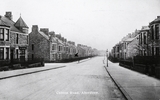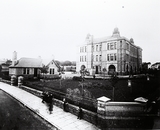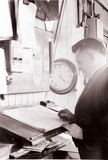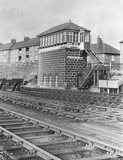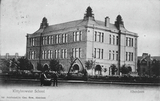|
Quick Search
|
Search Results
You searched for: Subject matches "Kittybrewster" or its children
13 items
items as
Clifton Road, Aberdeen
213 This view from around 1910 shows Clifton Road looking south at its crossroads with Leslie Road and Hilton Street. Clifton Road runs north from Kittybrewster to Woodside, which was a separate burgh form Aberdeen until 1891. It was originally call Tanfield Road but was renamed in 1894. These mainly granite terraced houses were being built during the 1890s. On the left of the photo are the premises of A.M. Black, grocer. This corner shop, at 104 Clifton Road, was run by Miss Agnes M. Black and Miss Margaret Black between 1902 and 1940. Their home was at 1 Leslie Road. The windows contain adverts for Rowntrees Chocolates and Fry's Pure Cocoa. Kittybrewster Primary School, Aberdeen
457 Kittybrewster Primary School, Great Northern Road, Aberdeen. Kittybrewster School
458 The school was opened 14th August 1899 on Great Northern Road with space for 1,100 eager to learn pupils!
This photographs shows the school, and the junction with Lilybank Place, looking north west from Great Northern Road.
The school was built by a popular Aberdeen builder named John Morgan who amongst other things also built the Caledonian Hotel, King Street School, various churches and the statue of William Wallace which stands opposite His Majesty's Theatre.
In the early days, students would have had to learn in a building with no heating and only outdoor toilets. Kittybrewster North signal box interior
509 Signal box interior at Kittybewster North. Signalman operates levers. Kittybrewster North Signalbox
510 Signalbox at Kittybrewster North. Signalman fills in train register. Railway line at Kittybrewster North
511 Railway line to Inverness at Kittybrewster North showing signal box and signals in the foreground. Great Northern Road, Aberdeen
1067 Great Northern Road, Aberdeen. Kittybrewster Primary School is on the left of the image. Astoria Cinema, Aberdeen
1152 The exterior of the Astoria Cinema, Clifton Road, Kittybrewster, Aberdeen, c.1960. In 1934, a new cinema was built on part of the old Central Park, just north of Kittybrewster Auction Marts. It was designed by the architect, T. Scott Sutherland, and was opened on 8th December 1934, with space for more than 2000 people. Its proximity to the relatively new housing areas of Kittybrewster, Powis, Woodside and Hilton should have ensured its success. It was made of concrete over a steel framework, with the roof sloping in a series of steps to produce the best acoustics. It had a colour scheme of light pink, invory and brown with walnut panelling and 2 miles of Wilton carpet. It closed on Saturday 13th August 1966, re-opening later that month as a Bingo Hall but that only lasted a few months and it finally closed in January 1967. In April 1967, it was being demolished and the site redeveloped as a shopping complex. The cinema had had one of the latest Compton theatre organs, which had been removed piece by piece and restored to be placed in the hall of Powis Academy. In November 1982, an arson attack destroyed the organ. Railway line at Kittybrewster
1506 This image has not yet been indexed. Use the Comments button below the image to enter information about the photograph.
Please note: we will not include any personal information provided unless you indicate that you wish to be acknowledged. The standard form for crediting your information is (name, place) e.g. (John Smith, Aberdeen). Aberdeen Cinemas: Astoria
3430 An Aberdeen Journals Archive photograph of the Astoria in around 1943. This super-cinema in Kittybrewster was opened in 1934 and was located at the end of Powis Terrace, at the start of Clifton Road and at its junction with Great Northern Road. This photograph looks towards Clifton Road from this location.
The film being shown at the time is Air Force with John Garfield. The premises of Birrell, confectioners, and George A. Davidson, provision merchant, can also be seen in the image.
Michael Thomson in Silver Screen in the Silver City (1988) tells the story of the cinema. The Astoria was primarily the brainchild of Bert Darley who had quit Poole's, proprietors of the Palace and Regent, and started up a new company called the Aberdeen Astoria Cinema Ltd. with various local businessmen and financial backers.
The giant cinema, designed by Thomas Scott Sutherland, was intended to serve the growing population of Kittybrewster, Powis, Woodside and Hilton. Construction on the £45,000 building proceeded quickly and it was opened on 8th December 1934 with screenings of a film called I Give My Love.
Thomson states that the Astoria's emphasis was on "spaciousness, relying upon simplicity of form to create a pleasing impression of clean-lined functionality." The space of the site allowed Scott Sutherland to enlarge on ideas first used at the Regent. The concept was again a tall central section, incorporating three main windows, with smaller side portions on either side.
The Astoria, along with the Capitol, was one of only two Aberdeen cinemas with a theatre organ. Both were equipped with top-of-the-line Compton organs at the time of their opening.
In March 1936 James F. Donald (Aberdeen Cinemas) Ltd. acquired a controlling share interest in the Aberdeen Astoria Cinema company. Richard Donald replaced Bert Darley as the manager at the Kittybrewster venue.
The programmes of the Astoria and the Kingsway on King Street were regularly linked, both being Donald cinemas. In the 1950s they showed Cinemascope films such as King of the Khyber Rifles and Beneath the Ten Mile Reef.
The cinema's last film was The Moving Target, with Paul Newman and Lauren Becall, shown on 13th August 1966. On the 29th of that month the venue reopened as a bingo hall. This was at the height of the game's popularity, however not even it could save the Astoria. At the end of the year the Donalds the site for redevelopment as a shopping complex. Demolition on the cinema was begun in April 1967.
Michael Thomson explains that all removable fittings and materials were salvaged. Additionally, the Compton organ was transferred to the school hall of Powis Academy. It served the school well for many years before unfortunately being destroyed in a fire during the night of 20th November 1982.
[Information primarily sourced from Silver Screen in the Silver City (1988) by Michael Thomson]
Image © Aberdeen Journals Ltd. Kittybrewster School, Aberdeen
4183 Looking north east from Lilybank Place towards Kittybrewster School in around 1905. The green of Kittybrewster & Woodside Bowling Club is in the foreground. A whale bone arch can also be seen in front of the school.
In April 1897, the Aberdeen School Board submitted plans to erect a new school at the Old Boathouse on the west side of Great Northern Road. It was completed at a cost of over £12,000 in time for the commencement of the new school term on 15th August 1899.
Built of granite, in the Renaissance style, it consisted of 3 floors, housing 16 classrooms and could accommodate up to 1,200 children. In addition, it was fully equipped with a gymnasium and rooms for cookery, manual instruction and science. The respected headmaster was George F. Duthie, an ex-president of the Educational Institute of Scotland.
This image is from a postcard, no. 343, published by George Bow of Aberdeen. |



